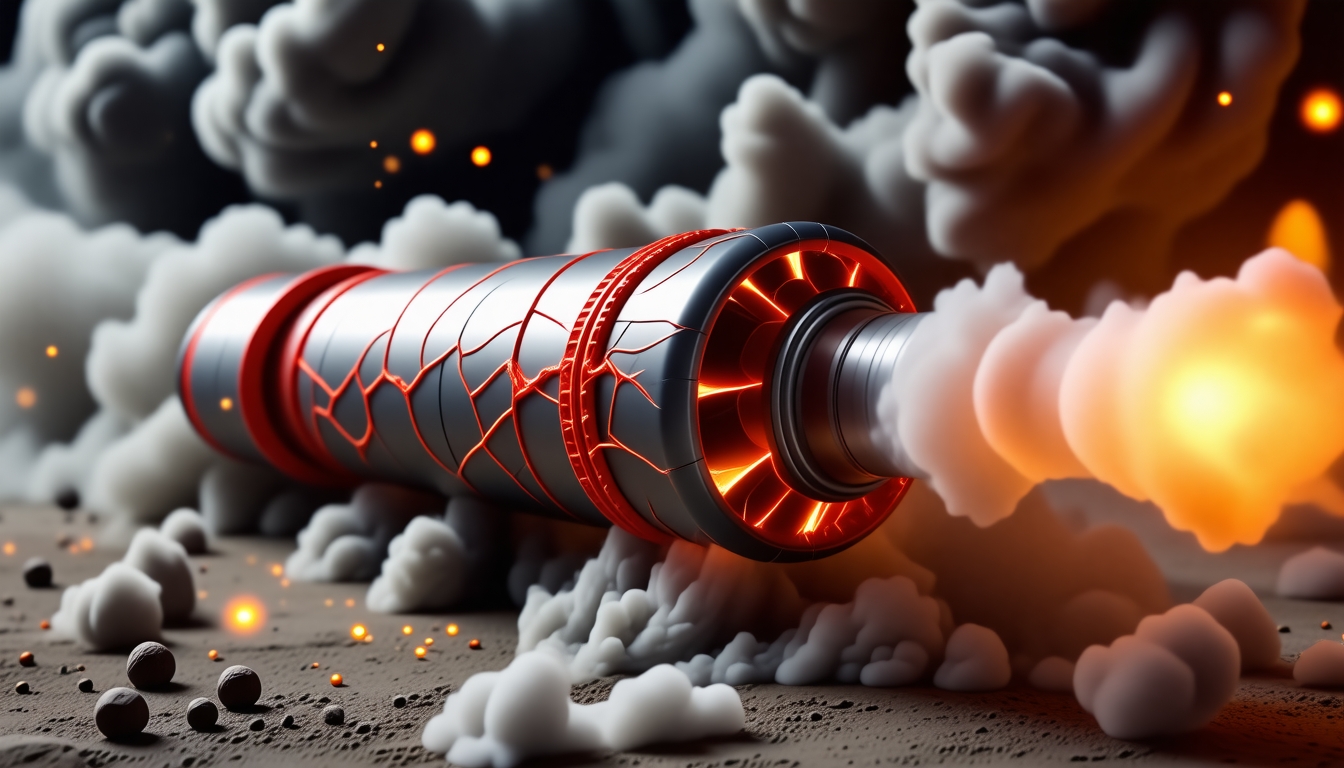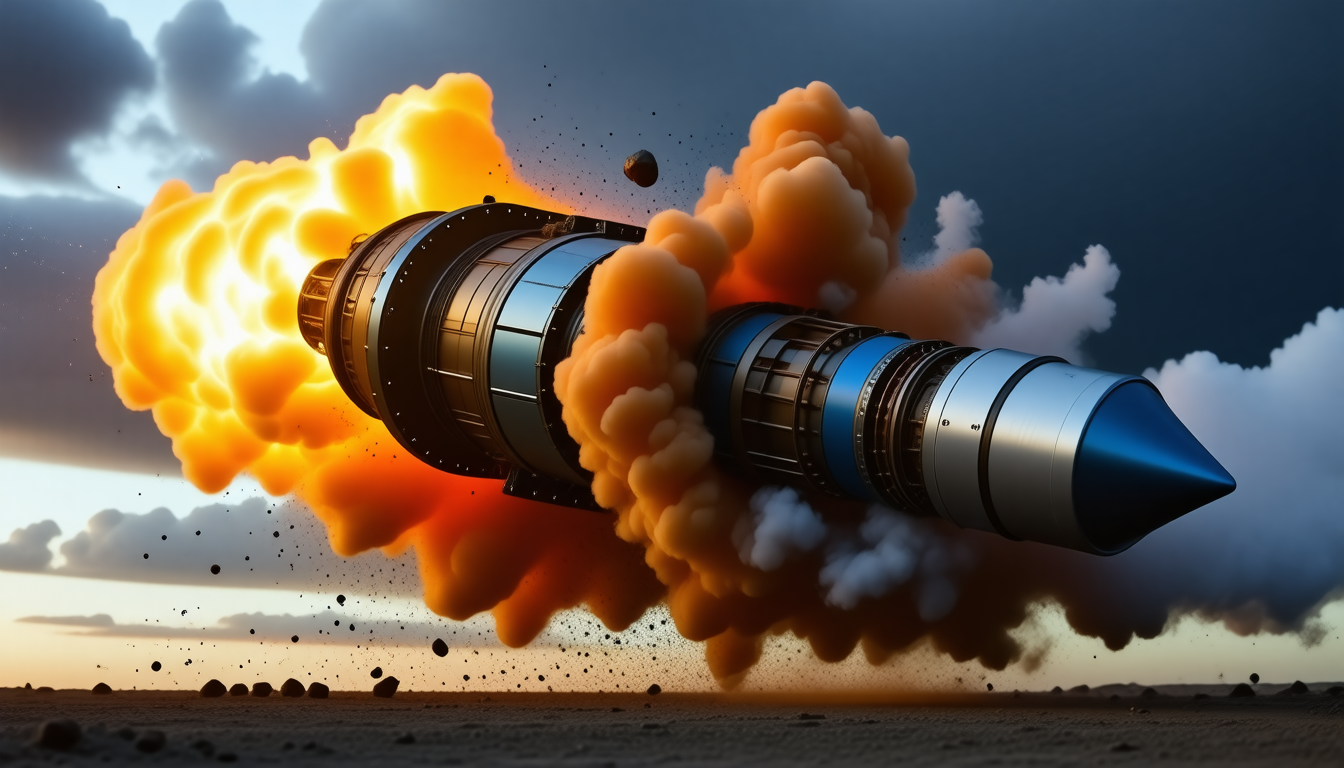Now Reading: Rocket Failures Unmasked: Learning from Catastrophes in 3D Printing
-
01
Rocket Failures Unmasked: Learning from Catastrophes in 3D Printing
Rocket Failures Unmasked: Learning from Catastrophes in 3D Printing


Understanding the Rocket Failure Mechanism
The recent test of a 3D-printed combustion chamber ended in a dramatic failure that highlights the hidden complexities involved in modern rocket engineering. At the heart of this incident lies a deeper understanding of the mechanics of rocket failure—a concept that, while often shrouded in technical jargon, can be distilled into a few key principles.
When the combustion chamber detonated, observers witnessed the instantaneous detonations that characterized the failure sequence. First, the carbon-carbon nozzle extension, which was already identified as possessing a pre-existing defect, gave way, leading to a rapid disintegration of the combustion chamber itself. In what felt like mere moments, the engine transitioned from a state of controlled combustion to chaotic release, spewing liquid methane and oxygen; a cascade of failures that seemed to take place in an instant. But behind this apparent randomness lies a series of interconnected events defined by pressure dynamics, material properties, and unexpected weak points resulting from fabrication techniques.
To comprehend the failure mechanism, one must first consider the physics of stress and pressure within the combustion chamber. This chamber, filled with a combustible mixture under high pressure, presents a delicate balance where material integrity is paramount. The failure points often stem from microscopic defects—tiny fissures or inclusions created during manufacturing—that can act as stress concentrators. As the chamber heats up and pressure mounts during operation, these minors flaws can propagate unexpectedly, culminating in catastrophic failure.
In the case of the recent explosion, the nozzle had already surpassed its safe operational threshold due to the structural weaknesses. Engineers observe that as the nozzle failed, it would have transmitted a shockwave through the combustion chamber, potentially causing new fractures to form and propagate. The typical operational environment within the chamber—a combination of extreme pressures and temperatures—creates conditions ripe for dynamic stress fractures to emerge, especially when compounded by existing defects.
Using high-speed cameras, engineers can analyze crucial moments leading up to failure to pinpoint critical events. These frame-by-frame breakdowns reveal how cracks initiate, slowly extend, and eventually overwhelm the materials intended to withstand immense forces. The disintegration wasn’t merely a powerful explosion; it’s a chain reaction of physics operating in real-time, where every minute detail—from the microstructure of the metal to the nuances in pressure distribution—plays a confirmed role in the outcome.
The combustion chamber, which had been designed to withstand these rigors, behaved far from ideally. Observations noted the lack of changing patterns in shock diamonds, indicating that while the nozzle change could affect the expansion and thrust dynamics, the presence of pre-existing defects was far more critical in determining ultimate chamber failure.
This incident acts as a stark reminder of the engineering mantra: “defects are not just minor inconveniences; they represent significant risk factors.” Rigorous testing and analysis reveal that every element, no matter how minute, contributes cumulatively to the structural integrity of the entire system.
While the catastrophic failure at the test stand may appear as an unfortunate event, it underscores the need for continued learning and assessment in the field of rocket systems, especially concerning the tolerances of materials used and the methods employed in their manufacture. Recognizing that single failures are often representative of compounded issues within a system very important for engineers focused on building reliable and safe rocket technologies.
Components of the 3D Printed Combustion Chamber
The combustion chamber, an essential component of rocket engines, embodies the intersection of advanced engineering and innovative manufacturing technologies. In modern aerospace applications, where reliability and efficiency are paramount, the shift towards 3D printing heralds a revolution in the way these chambers are designed and constructed. This technology facilitates the creation of complex geometries previously unachievable with traditional manufacturing processes, significantly enhancing the performance potential of rocket engines. However, with these advancements come new challenges and considerations that can influence the integrity of the components.
At the heart of the combustion chamber’s design is its ability to endure and control the intense thermal and pressure conditions experienced during rocket engine operation. In the case of the combustion chamber that experienced failure, engineers employed a specially formulated copper-chromium-niobium alloy—a material known for its excellent thermal conductivity and performance characteristics at elevated temperatures. This alloy allows for more efficient heat dissipation, an essential aspect as the chamber is recycled with supercooled propellants like liquid methane and liquid oxygen, each filling a vital role in the combustion process.
The intricacies of the combustion chamber are further refined through the use of innovative cooling techniques. As pressure fluctuates and combustion occurs, cooling channels integrated into the design become crucial. Through these channels, propellant flows to remove heat generated during combustion, ensuring that structural integrity is maintained. This process not only helps avoid heat-related failure but also enhances overall engine efficiency by allowing for higher operating temperatures, ultimately leading to increased thrust capability.
The use of 3D printing introduces benefits like reduced weight and increased design freedom, allowing engineers to iterate designs quickly. However, it also necessitates a rigorous examination of the manufacturing processes to avoid introducing defects that can compromise structural strength. Each layer in the additive manufacturing process represents a point where issues can arise. The layer-by-layer construction can lead to inconsistencies in material density and quality, resulting in porosity—tiny voids within the material structure that can weaken the chamber. These characteristics may not be visible until subjected to extreme conditions, at which point, what seemed like an innocuous imperfection can escalate into catastrophic failure.
The recent failure of the combustion chamber reveals just how critical the interplay of materials and manufacturing methods is. During the analysis of the failed components, engineers discovered that not all layers had achieved adequate melting, leading to unmelted powder residues and potential contamination from cleaning interruptions during the printing process. The presence of these imperfections provides a fertile ground for fractures to propagate, as observed in the initial separations around the 8:00 position. Scientists posited that microscopic anomalies could concentrate stress, facilitating crack initiation and propagation under operational stresses.
Moreover, the additive manufacturing process’s sensitivity to external variables exacerbates the risks of producing subpar components. Variations in temperature, laser energy, or even dust accumulation on optics can greatly affect the resulting material properties, leading to an unpredictable quality in the printed parts. It’s a complex game of precision where engineers must deeply understand these interactions to mitigate risks altogether.
Post-processing steps, such as hot isostatic pressing, serve as essential tools in enhancing the final properties of the printed components. This process aids in reducing porosity and removing internal voids by applying heat and isostatic pressure—processes vital for achieving the robust characteristics required in aerospace applications. Yet, the mere application of post-processing systems does not guarantee the elimination of defects; each stage in the manufacturing process intertwines with others, demanding a holistic approach to quality control.
In essence, the combustion chamber serves not only as a critical component responsible for thrust generation but also as a case study in the larger narrative of aerospace engineering. Every decision made—from materials selection and design intricacies to manufacturing processes applied—must coalesce into a singular focus on reliability and safety. The capabilities offered by 3D printing illustrate the promise of innovation in rocketry, yet they also emphasize that the quest for perfection remains an ongoing journey of refinement and learning in the context of aerospace engineering.

Analysis of Defects in Manufacturing Process
The examination of defects within the manufacturing process of the 3D-printed combustion chamber reveals a tapestry woven with intricacies, reflecting the challenges faced when merging modern technology with the rigors of aerospace engineering. Every detail left behind by the manufacturing process could become not just a minor inconvenience but a critical flaw lurking beneath the surface—one that has the potential to escalate dramatically during the actual firing of a rocket engine.
Within the scope of additive manufacturing, particularly in the context of creating components like combustion chambers, each layer of material adds both capability and complexity. The operation employed here, using laser powder bed fusion, allows for astounding geometrical complexity that was once the stuff of theoretical discussions or unattainable designs. The issue, however, lies in how this process can simultaneously introduce both innovation and vulnerability. Every layer is deposited with the hope of achieving perfect fusion and homogeneity—the quest for a flawless component devoid of pitfalls. However, the reality is often dictated by the nuances of the machinery and environment surrounding the process.
Engineers engaged in this project identified three significant interruptions during the manufacturing of the combustion chambers—each acting as a unique harbinger of the potential catastrophes that could ensue. When the machine was halted, whether for cleaning or due to power outages, the very integrity of the build became susceptible to contamination, porosity, and defects. As highlighted in the analysis, not all layers achieved the requisite melting due to insufficient energy input, causing unmelted powder residues that would compromise structural strength. Even the seemingly trivial act of opening the machine may have caused foreign substances to infiltrate the delicate matrix of the additive structure, contributing to the formation of microscopic cracks.
During the post-mortem investigation, engineers meticulously inspected each combustion chamber that had undergone testing, focusing on the fateful moments of failure. Anomalies observed in the structural integrity, such as the stark deformations and cracks, became a roadmap for understanding the failure mechanism. Crucially, these defects proved not merely incidental but indicative of a more systemic issue that highlighted the fragile link between manufacturing quality and operational outcomes. The phenomenon of increased porosity in higher layers suggested that variations in the laser’s behavior—not just its power output—played a pivotal role in determining the fusion quality of subsequent layers. Dust accumulation on optics or fluctuations in environmental conditions could lead to inconsistencies that manifest themselves in strikingly catastrophic ways.
A striking aspect of the analysis rested on the realization that the proportion of the defects—ranging from the microscale to those perceptibly observable—culminated in a failure mechanism that was not isolated to a single faltering event but was rather a complex interplay of various process parameters. This intertwining of factors elucidated the mantra that, in rocket science, potential failure risks must be robustly managed through meticulous process control. Even a mere 1% increase in defect rates could dramatically shift the landscape, hampering structural integrity and precipitating unforeseen catastrophic outcomes during testing.
The necessity for stringent regulation of manufacturing processes is further underscored by the inspection results of the printed components. By employing advanced techniques such as electron microscopy, researchers could delve deeper into the minutiae of the materials, revealing where stress zones occurred and the pathways taken by propagating cracks. The findings were sobering; defects stemmed not merely from one point of failure but from a chain reaction relationally linked to the broader manufacturing ecosystem—encompassing everything from laser specifics to environmental control during the build process.
Moreover, the hot isostatic pressing method employed post-print aimed to rectify some of these shortcomings, attempting to ensure that the defects were addressed through thermal treatment and isostatic pressure. Yet, even this process is not a panacea; careful calibration and execution of the hot isostatic pressing techniques are paramount. When conducted inadequately, they can introduce their own vulnerabilities, adding yet another layer of risk in an already fragile system of interplay between manufacturing and engineering.
This confluence of additive manufacturing with the aerospace realm calls for an evolving methodology—one that embodies a commitment to continued innovation while imposed with a disciplined adherence to quality control as the bedrock of successful operational outcomes. Engineers are left with the responsibility of not just producing components—crafting a combustion chamber is but a singular moment in time; the broader ask is to create reliable transport vessels amidst the chaotic backdrop of engineering marvels. The lessons gleaned from this combustion chamber’s failures extend far beyond this singular test, accentuating the imperative for concerted advancements in manufacturing technologies to support the unforgiving rigors of space exploration.
Mitigating Risks in Rocket Engine Production
The recent failure of a 3D-printed combustion chamber during testing serves as a poignant reminder of the rigorous demands placed upon modern rocket technology. To ensure the reliability and safety of such intricate systems, the industry must navigate a labyrinth of challenges, not only in the design and material selection but also in the manufacturing processes used. As aerospace engineers and manufacturers reflect on this event, several key strategies can be developed to mitigate risks and enhance the operational integrity of rocket components.
One of the foundational aspects of mitigating risks in rocket engine production lies in establishing robust process controls that can effectively monitor and adjust manufacturing techniques. The use of real-time data monitoring presents a powerful opportunity for engineers to observe parameters that influence the additive manufacturing process, such as laser power, scanning speed, and layer thickness. By implementing advanced sensors within the manufacturing environment, operators can receive immediate feedback on deviations from established norms, allowing for dynamic adjustments to maintain quality.
Moreover, the process of additive manufacturing should incorporate redundancy in quality checks, wherein multiple inspections are conducted throughout various stages of production. Engineers can employ methods like non-destructive testing (NDT), alongside traditional inspections, to assess the integrity of the printed parts before they experience operational stress. Techniques such as computed tomography (CT) scanning, which offers three-dimensional imagery of structures, can reveal internal porosity and other defects that might otherwise be missed. Integrating these advanced inspection methodologies not only provides a deeper understanding of potential weaknesses but can enable engineers to make informed decisions about a part’s readiness for testing.
Another pivotal approach in reducing manufacturing risks involves optimizing the design for additive manufacturing. Design techniques that account for the unique characteristics of 3D printing can significantly influence the manufacturability and performance of components. This means embracing a more innovative mindset during the design phase, allowing for geometries that take full advantage of the layer-by-layer deposition process while minimizing areas prone to stress concentration. Using computational modeling and simulation tools enables engineers to predict how different designs will react under thermal and mechanical loads, allowing for preemptive alterations before any production begins.
Furthermore, narrowing down and standardizing material choices across production lines can streamline the process and increase cohesiveness in performance. By focusing on a select number of high-performance materials known for their reliability in extreme conditions, manufacturers can not only enhance component performance but also reduce the complexity of supply chains and quality assurance processes. That is particularly important in relation to recent findings that highlight the differences in properties observed in layers throughout the printed components—issues often exacerbated by the variability in material handling and preparation procedures.
Cultivating a culture of interdisciplinary collaboration between production, engineering, and quality assurance teams is also crucial. Workers should be encouraged to share insights, observations, and lessons learned from previous designs and production attempts. Such an approach fosters a unified understanding of how various factors impact the final output and nurtures a proactive mindset that prioritizes risk assessment at every stage of the process. Regular cross-departmental workshops can solidify these concepts, where teams collaboratively navigate problem-solving scenarios related to potential manufacturing risks.
Moreover, as testing continues to play a critical role in refining aerospace components, the methodology behind these tests must also adapt. Incremental testing—which emphasizes gradual increases in operational pressure and temperature—enables engineers to observe a component’s behavior under controlled conditions before full-scale implementation. This technique not only reduces the risk of catastrophic failure during test firing, but it also offers valuable data that can be analyzed to draw correlations between design choices, material performance, and actual stress modalities experienced during operational conditions.
Finally, continuous improvement through iterative feedback loops is paramount. Each test and failure provides not just a data point but a valuable opportunity to enhance the understanding of the component’s functionalities. Engineers must embrace a failure-tolerant mindset where each setback is analyzed thoroughly, leading to well-documented adjustments in processes and materials. This practice aligns closely with the principles of lean manufacturing, which emphasizes maximizing value while minimizing waste, thus enhancing the overall efficiency of production processes.
The recent incident involving the combustion chamber exemplifies the need for a multifaceted approach to risk mitigation in rocket engine production. By combining modern manufacturing techniques with rigorous quality controls, proactive design strategies, collaborative cultures, and an iterative testing framework, the aerospace industry can continue to push the boundaries of innovation while safeguarding against the hidden risks that might otherwise remain in the shadows. With each step forward, engineers move closer to realizing the full potential of reliable and safe rocket systems, using the ambitions of space exploration for generations to come.
Stay Informed With the Latest & Most Important News
Previous Post
Next Post
-
 012024 in Review: Highlights from NASA in Silicon Valley
012024 in Review: Highlights from NASA in Silicon Valley -
 02Panasonic Leica Summilux DG 15mm f/1.7 ASPH review
02Panasonic Leica Summilux DG 15mm f/1.7 ASPH review -
 03From Polymerization-Enabled Folding and Assembly to Chemical Evolution: Key Processes for Emergence of Functional Polymers in the Origin of Life
03From Polymerization-Enabled Folding and Assembly to Chemical Evolution: Key Processes for Emergence of Functional Polymers in the Origin of Life -
 04How New NASA, India Earth Satellite NISAR Will See Earth
04How New NASA, India Earth Satellite NISAR Will See Earth -
 05And Thus Begins A New Year For Life On Earth
05And Thus Begins A New Year For Life On Earth -
 06Astronomy Activation Ambassadors: A New Era
06Astronomy Activation Ambassadors: A New Era -
07SpaceX launch surge helps set new global launch record in 2024




















